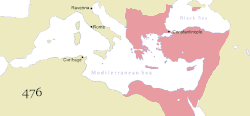
Back Belagerung von Konstantinopel (1453) ALS فتح القسطنطينية Arabic سقوط القسطنطنيه ARZ Cayida de Constantinopla AST Konstantinopolun süqutu Azerbaijani ایستانبولون فتحی AZB Аблога Канстанцінопаля (1453) Byelorussian Падзеньне Канстантынопалю BE-X-OLD Падане на Константинопол (1453) Bulgarian কনস্টান্টিনোপল বিজয় Bengali/Bangla
| Fall of Constantinople | |||||||||
|---|---|---|---|---|---|---|---|---|---|
| Part of the Byzantine–Ottoman wars and the Ottoman wars in Europe | |||||||||
 The siege of Constantinople (1453), French miniature by Jean Le Tavernier after 1455. | |||||||||
| |||||||||
| Belligerents | |||||||||
| |||||||||
| Commanders and leaders | |||||||||
| Strength | |||||||||
|
Land forces:
Naval forces:
|
Land forces:
Naval forces: | ||||||||
| Casualties and losses | |||||||||
|
200–18,000[10] (first day) Heavy: 15,000–50,000 (disputed) |
4,500 killed in action (both military and civilian)[11][12][13] 30,000–50,000 civilians enslaved[14][15][16] | ||||||||
| History of the Byzantine Empire |
|---|
 |
| Preceding |
| Early period (330–717) |
| Middle period (717–1204) |
| Late period (1204–1453) |
| Timeline |
| By topic |
|
|
The fall of Constantinople, also known as the conquest of Constantinople, was the capture of the capital of the Byzantine Empire by the Ottoman Empire. The city was captured on 29 May 1453 as part of the culmination of a 53-day siege which had begun on 6 April.
The attacking Ottoman Army, which significantly outnumbered Constantinople's defenders, was commanded by the 21-year-old Sultan Mehmed II (later nicknamed "the Conqueror"), while the Byzantine army was led by Emperor Constantine XI Palaiologos. After conquering the city, Mehmed II made Constantinople the new Ottoman capital, replacing Adrianople.
The conquest of Constantinople and the fall of the Byzantine Empire was a watershed of the Late Middle Ages, marking the effective end of the Roman Empire, a state which began in roughly 27 BC and had lasted nearly 1500 years. For many modern historians, the fall of Constantinople marks the end of the medieval period and the beginning of the early modern period.[17][18] The city's fall also stood as a turning point in military history. Since ancient times, cities and castles had depended upon ramparts and walls to repel invaders. The Walls of Constantinople, especially the Theodosian Walls, were some of the most advanced defensive systems in the world at the time. For 800 years, the Theodosian Walls, regarded by historians as the strongest and most fortified walls in the ancient and medieval era, protected Constantinople from attack.[19] However, these fortifications were overcome with the use of gunpowder, specifically from Ottoman cannons and bombards, heralding a change in siege warfare.[20] The Ottoman cannons repeatedly fired massive cannonballs weighing 500 kilograms (1,100 lb) over 1.5 kilometres (0.93 mi) which created gaps in the Theodosian Walls for the Ottoman siege.[21][22]
- ^ Buc (2020).
- ^ Ivanović (2019).
- ^ a b Giardinetto (2022).
- ^ "Mahmud Paşa". Archived from the original on 26 June 2023. Retrieved 26 June 2023.
- ^ a b Lilie (2005), p. 464.
- ^ Cite error: The named reference
pertusicadvol1was invoked but never defined (see the help page). - ^ Cite error: The named reference
Fall of Constantinoplewas invoked but never defined (see the help page). - ^ Cite error: The named reference
osmanaras600askeriwas invoked but never defined (see the help page). - ^ Nicol (2002), p. 57.
- ^ Crowley (2013b), p. 104: "As always casualty figures varied widely; Neskor-Iskander gave the number of Ottoman dead at 18,000; Barbaro a more realistic 200"
- ^ "Geographical Record". Geographical Review. 11 (4): 611–629. 1921. ISSN 0016-7428. JSTOR 208254.
Less excusable still is the treatment accorded to the statements of Kritopoulos, that 4,500 were killed at the fall of Constantinople.
- ^ Nicolle (2000), p. 41.
- ^ Labatt, Annie (October 2004). "Constantinople after 1261". Archived from the original on 30 June 2022. Retrieved 30 June 2022.
- ^ Cite error: The named reference
iK51Wwas invoked but never defined (see the help page). - ^ Akbar (2002), p. 86: "Some 30,000 Christians were either enslaved or sold."
- ^ Davis, Paul K. (2003). Besieged: 100 Great Sieges from Jericho to Sarajevo. Oxford University Press. p. 84. ISBN 978-0-19-521930-2. Archived from the original on 6 January 2024. Retrieved 10 April 2022.
- ^ Cite error: The named reference
ealoipoliswas invoked but never defined (see the help page). - ^ Cite error: The named reference
GpAG8was invoked but never defined (see the help page). - ^ Cartwright, Mark. "Theodosian Walls". World History Encyclopedia. Archived from the original on 30 April 2023. Retrieved 30 April 2023.
- ^ "The fall of Constantinople". The Economist. 18 June 2017. Archived from the original on 18 June 2017. Retrieved 30 April 2023.
- ^ Cartwright, Mark. "1453: The Fall of Constantinople". World History Encyclopedia. Archived from the original on 2 June 2023. Retrieved 30 April 2023.
- ^ Silverburg, Sanford R. (26 January 2007). "The Middle East Online: Series 1: Arab-Israeli Relations, 1917–1970. Edited by Eugene Rogan. Farmington Hills, MI: Thomson Gale". Microform & Imaging Review. 36 (2). doi:10.1515/mfir.2007.75. ISSN 0949-5770. S2CID 162273820.
Cite error: There are <ref group=note> tags on this page, but the references will not show without a {{reflist|group=note}} template (see the help page).
© MMXXIII Rich X Search. We shall prevail. All rights reserved. Rich X Search